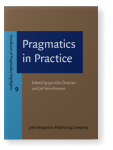Katarzyna M. Jaszczolt
Formerly known as Kasia M. Jasczcolt
List of John Benjamins publications for which Katarzyna M. Jaszczolt plays a role.
Yearbook
Space and Time in Languages and Cultures: Linguistic diversity
Edited by Luna Filipović and Katarzyna M. Jaszczolt
[Human Cognitive Processing, 36] 2012. xv, 492 pp.
Subjects Cognition and language | Pragmatics | Semantics | Syntax | Theoretical linguistics
Space and Time in Languages and Cultures: Language, culture, and cognition
Edited by Luna Filipović and Katarzyna M. Jaszczolt
[Human Cognitive Processing, 37] 2012. xiii, 363 pp.
Subjects Cognition and language | Pragmatics | Semantics | Syntax | Theoretical linguistics
Meaning Through Language Contrast: Volume 1
Edited by Katarzyna M. Jaszczolt and Ken Turner
[Pragmatics & Beyond New Series, 99] 2003. xii, 388 pp.
Subjects Comparative linguistics | Pragmatics | Semantics
Meaning Through Language Contrast: Volume 2
Edited by Katarzyna M. Jaszczolt and Ken Turner
[Pragmatics & Beyond New Series, 100] 2003. viii, 496 pp.
Subjects Comparative linguistics | Pragmatics | Semantics
Meaning Through Language Contrast: 2 Volumes (set)
Edited by Katarzyna M. Jaszczolt and Ken Turner
[Pragmatics & Beyond New Series, 99-100] 2003. xii, 388 pp. & viii, 496 pp.
Subjects Comparative linguistics | Pragmatics | Semantics
2022 Contrastive analysis Handbook of Pragmatics: Manual, Verschueren, Jef and Jan-Ola Östman (eds.), pp. 1499–1504 | Chapter
2016 Temporal Reference Without the Concept of Time? Conceptualizations of Time, Lewandowska-Tomaszczyk, Barbara (ed.), pp. 3–24 | Article
In this article I argue that whatever the preferred construal of time is, it is
always further reducible to one that assumes tenseless reality. In particular,
I argue for the superiority of an approach according to which the differences
between the future, present and past are quantitative on the… read more
2012 Introduction: Linguistic diversity in the spatio-temporal domain Space and Time in Languages and Cultures: Linguistic diversity, Filipović, Luna and Katarzyna M. Jaszczolt (eds.), pp. 1–12 | Article
2012 Introduction: Linguistic, cultural, and cognitive approaches to space and time Space and Time in Languages and Cultures: Language, culture, and cognition, Filipović, Luna and Katarzyna M. Jaszczolt (eds.), pp. 1–11 | Article
2012 Context: Gricean intentions vs. two-dimensional semantics What is a Context?: Linguistic approaches and challenges, Finkbeiner, Rita, Jörg Meibauer and Petra B. Schumacher (eds.), pp. 81–104 | Article
The article analyses the concepts of context used in two-dimensional formal semantic accounts of Kaplan and Stalnaker and in selected versions of post-Gricean contextualism. It focuses on the question of contextual parameters employed in “context as index” on the one hand, and on free, top-down… read more
2012 5. Cross-linguistic differences in expressing time and universal principles of utterance interpretation Space and Time in Languages and Cultures: Linguistic diversity, Filipović, Luna and Katarzyna M. Jaszczolt (eds.), pp. 95–122 | Article
This chapter addresses the question how linguistic diversity and universalism in the domain of representing time can be reconciled. It is demonstrated how the contextualist theory of Default Semantics (Jaszczolt 2005, 2009, 2010a) accounts for cross-linguistic differences in conveying temporal… read more
2012 Foreword: Space and time in languages, cultures, and cognition Space and Time in Languages and Cultures: Language, culture, and cognition, Filipović, Luna and Katarzyna M. Jaszczolt (eds.), pp. xi–xiii | Foreword
2011 Contrastive analysis Pragmatics in Practice, Östman, Jan-Ola and Jef Verschueren (eds.), pp. 111–117 | Article
2011 Communicating about the past through modality in English and Thai Cognitive Approaches to Tense, Aspect, and Epistemic Modality, Patard, Adeline and Frank Brisard (eds.), pp. 249–278 | Article
The chapter concerns semantic representation of past-time reference. It begins with the proposal that temporality be subsumed under the category of epistemic modality, understood as a degree of detachment from the content of the expressed proposition. We present arguments in support of this stance… read more
2007 The syntax-pragmatics merger: Belief reports in the theory of Default Semantics Pragmatic Interfaces, Saussure, Louis de and Peter J. Schulz (eds.), pp. 41–64 | Article
This paper is a voice in the ongoing discussion on the source and properties of pragmatic inference that contributes to the representation of discourse meaning. I start off from the contextualist standpoint of truth-conditional pragmatics (TCP, Recanati 2002, 2003, 2004) and develop a proposal of… read more
2006 Default interpretations Handbook of Pragmatics: 2006 Installment, Verschueren, Jef and Jan-Ola Östman (eds.), pp. 1–29 | Article
2003 On translating ‘What is said’: Tertium comparationis in contrastive semantics and pragmatics Meaning Through Language Contrast: Volume 2, Jaszczolt, Katarzyna M. and Ken Turner (eds.), pp. 441–462 | Article
2003 Editorial preface Meaning Through Language Contrast: Volume 1, Jaszczolt, Katarzyna M. and Ken Turner (eds.), pp. xi–xii | Miscellaneous
1995 Review of Schreuder & Weltens (1993): The bilingual lexicon Studies in Language 19:2, pp. 563–569 | Review
1995 Contrastive analysis Handbook of Pragmatics: Manual, Verschueren, Jef, Jan-Ola Östman and Jan Blommaert † (eds.), pp. 561–565 | Article















